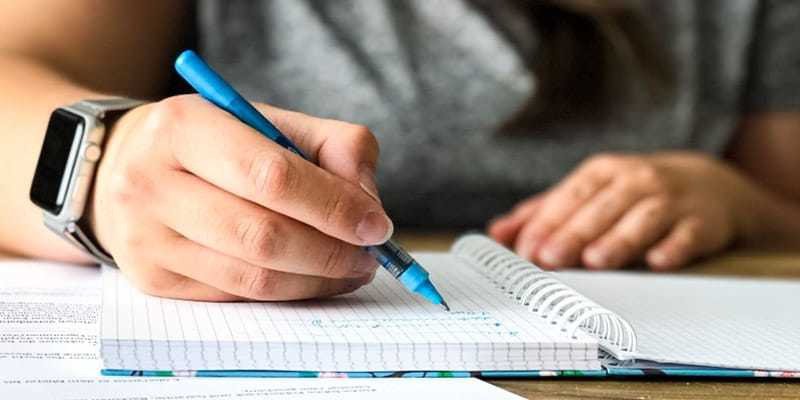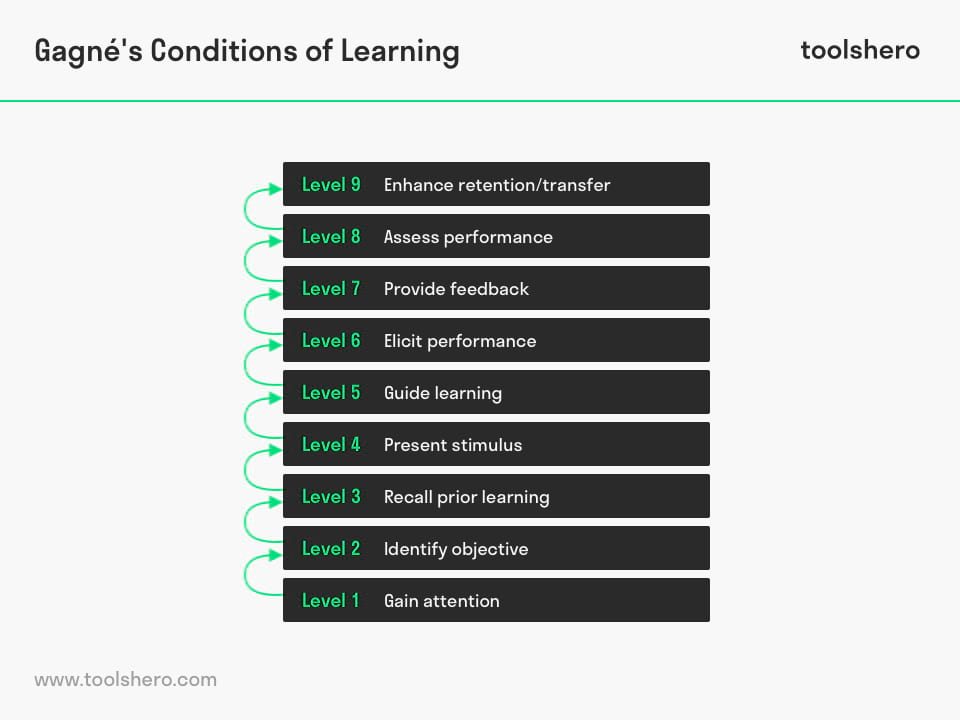Gagné’s Conditions of Learning

Gagné’s Conditions of Learning: this article provides a practical explanation of Gagné’s Conditions of Learning. After reading, you’ll have a basic understanding of this powerful effectiveness tool.
What are Gagné’s Conditions of Learning?
Gagné’s Conditions of Learning is a book written by psychologist Robert M. Gagné, and describes different kinds of learning and nine instructions for effective learning. Gagné’s Conditions of Learning is also known as Gagné’s Taxonomy of Learning, and Gagné’s Nine Events of Instruction. The theory posits that there are different levels of learning, and each level demands different instructions.
Robert Gagné defines learning as a change in an individual’s capacities that continues during a specific period, and that cannot be ascribed to the natural process of ageing.
Moreover, he writes that he views learning as a resource that individuals and groups of people can use to acquire the skills needed to become a full-fledged member of society. According to the psychologist, learning is a direct result of human capacities and behaviours that take place through stimulation from the environment and the individual thought processes.
The roots of Robert Gagné’s work lie in the concept of behaviourism. This theory describes that, through analysis of perceived behaviour, necessary components to acquire a specific skill can be identified.
From observations during learning, Gagné noticed that an individual was completely dependent on previously acquired knowledge. This led to his claim that instructions for learning must consist of logically built-up steps that draw on what has already been learned.
Many experts note that Robert Gagné’s taxonomy is an expansion of Benjamin Bloom’s taxonomy. His theory highlighted the idea that individuals learn in three different domains: cognitive, affective and psychomotor domains.
Gagné’s Conditions of Learning contains five categories of learning
The book Conditions of Learning contains various main categories of learning. Different internal and external conditions are needed for each kind of learning.
For instance, to learn cognitive strategies, the student or learner must have the opportunity to practise developing a new solution to the established problems. For this purpose, the student must be exposed to a convincing role model or convincing arguments.
Gagné’s Conditions of Learning describes several requirements for learning for each category.
Intellectual Skills
Intellectual skills, also known as procedural skills, is the easiest way to identify a student’s readiness. These skills encompass concepts, procedures and rules. This is also referred to as ‘knowing how something must be done’.
- Use different contexts/perspectives
- Plan opportunities to practise and assess
- Use verbal indications for combining skills, knowledge or components
- Encourage the retrieval of previously gained knowledge
- Stay within the limits of the working memory; not too much at once
- Ask attention for deviating characteristics
Verbal Skills
The verbal skills are also called explanatory knowledge, and these determine whether the student is able to explain what he or she has learned. Explanatory knowledge consists of different types of knowledge that can be recalled in different ways. Here, as Gagné describes, previously learned knowledge helps in learning new information.
- Provide a meaningful context for effectively coding information
- Encourage the retrieval of previously gained knowledge
- Encourage the generalisation of information
- Present information in a manageable way
- Ask attention for deviating characteristics
Cognitive Strategies
Gagné’s Conditions of Learning defines the cognitive strategies as the way to enable students to exercise control over the processes involved in: participating, observing, coding, remembering, retrieving, and thinking in general. In other words, it means that the student develops his or her own personal way to learn, think and act. The instructions that are given form the essence of the cognitive perspective.
- Describe or demonstrate strategies
- Plan opportunities to practise the strategy and to assess the action after
- Give information and constructive feedback on the creativity or originality of a developed strategy or outcome
Motor Skills
Motor skills entail that it is analysed whether the student uses the right order when carrying out procedures, for instance. This concerns combining sub-skills. When improvement occurs in the smoothness of an action, the timing and the motion through practice, we call this motor learning.
- Plan opportunities to practise and assess
- Share verbal or other guidelines to determine the routine
- Share feedback on the accuracy of achievements immediately
- Encourage the use of mental exercises
Attitude
Attitudes are internal conditions that can’t always be perceived directly. Gagné’s Conditions of Learning describes attitudes as emotional components and cognitive components, because they influence behaviour. Attitudes also refer to the bias that influences the learner’s action compared to something or someone else.
- Develop success expectations based on the desired attitude
- Make sure that students have a role model
- Give feedback for successful achievements
Each of these learning categories requires different instructions. This is useful information for instructors, for instance. Leaders can creatively incorporate the information from Gagné’s Conditions of Learning into their lessons. The conditions or requirements can be alternated for better results.
The nine levels of learning within Gagné’s Conditions of Learning
According to Gagné, learning must be made as easy as possible by supporting the internal processes through the proper planning of educational activities. To make learning easier, Robert Gagné lists a series of nine instructions that support the learning process. He noted that these nine instructions should be used in every lesson.
Gagné and fellow researcher Driscoll posit that these events are effective when they are applied in the right order and in the right way. It doesn’t matter whether the instructions are given by a person or by the computer.
1. Gain attention
The first of the instructions from Gagné’s Condition of Learning is gaining attention. The principle for each learning process is that the student is motivated and is open to receiving new information. This can be achieved by mentioning the students by name, involving them in the problem, or calling them to order so their full attention is directed at the provider of information.
2. Identify objective
Students can more easily be involved in the process when they become aware of the learning objectives and of the skills they have gained at the end of the session. By sharing objectives with the students, they can develop their own expectations about what’s expected of them during the lessons.
3. Recall prior learning
A concept that often recurs in Gagnés Conditions of Learning is recalling previously learned knowledge. That’s important to clarify the context. Recalling prior knowledge can be facilitated in various ways, such as through a Q&A prior to the lesson. An online quiz is taken in the classrooms increasingly often, where students take a test on what they’ve previously learned.
4. Present stimulus
These instructions depend on the skill to be learned. It’s important that the stimulus is aimed at characteristics of the desired outcomes, so students can understand the nature and reason of the learning experience.
5. Guide learning
These instructions also depend on the desired result. Learning support concerns drawing on prior knowledge to advance the retention of information in the long term. This is done by offering a meaningful context to the students.
When they have questions or experience difficulties in solving problems or in coming up with solutions, there must be a guide who can point them to previously gained knowledge enabling them to solve the problem independently.
6. Elicit performance
The first five instructions attempt to ensure that the learning process is effective. These instructions, however, allow the student to demonstrate what they’ve learned to the people around them and to themselves. It concerns carrying out a learned skill as indication that the learning process has been successful.
7. Provide feedback
It’s crucial that the feedback students receive isn’t just based on whether or not the work is correct; it must also be discussed how well they’ve done, the areas that could do with improvement, and how their general performance can be improved.
8. Assess performance
These instructions, or the phase of the process, can only take place when the students have had sufficient opportunity to practise so a skill is fine-tuned. Most theories on learning agree that demonstrations of actions must be repeated through time to prove that knowledge has actually been gained.
It requires both a formative and summative assessment. Formative assessment is the continuous process of evaluation, and summative assessments take place at the end of a process to demonstrate that a skill or learning aspect has been mastered.
9. Enhance retention/transfer
Enhancing the retention of knowledge and the transfer of the knowledge is the last instruction of Gagné’s Conditions of Learning. It’s important to recognise the value of the use of different activities to optimise the retention and transfer of skills. There are various tools available for memory training, but in most cases, the best results are achieved through repetition.
Now It’s Your Turn
What do you think? Are you familiar with the explanation of Gagné’s Conditions of Learning? What do you believe are conditions for effective learning? Do you see similarities with other taxonomies, such as Benjamin Bloom’s taxonomy? Do you have any tips or additional comments?
Share your experience and knowledge in the comments box below.
More information
- Gagné, R. M. (1962). The acquisition of knowledge. Psychological review, 69(4), 355.
- Gagné, R. M. (1965). Conditions of learning.
- Gagné, R. M., & Briggs, L. J. (1974). Principles of instructional design. Holt, Rinehart & Winston.
- Gagné, R. M. (1975). Essentials of learning for instruction. Dryden Press.
- Gagné, R. M. (2013). Instructional technology: foundations. Routledge.
How to cite this article:
Janse, B. (2019). Gagné’s Conditions of Learning. Retrieved [insert date] from Toolshero: https://www.toolshero.com/personal-development/gagnes-conditions-of-learning/
Add a link to this page on your website:
<a href=”https://www.toolshero.com/personal-development/gagnes-conditions-of-learning/”>Toolshero: Gagné’s Conditions of Learning</a>
Published on: 27/11/2019 | Last update: 08/03/2022











